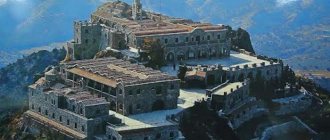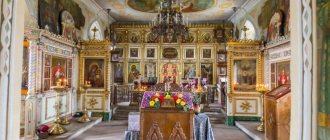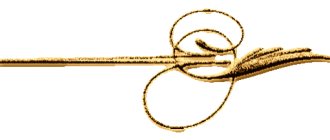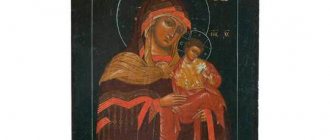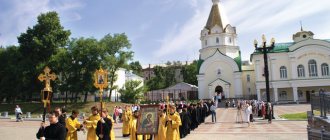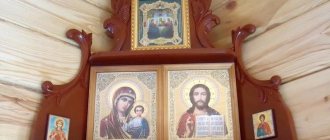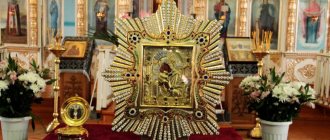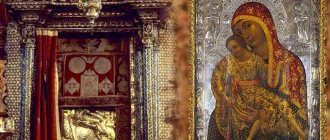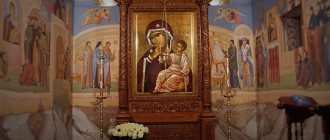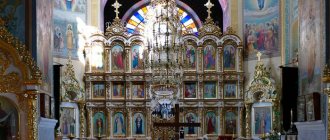One of the oldest images of the Mother of God is considered to be the icon of the Mother of God “Oranta” (Praying). Another name that is often found is the icon of the Mother of God “Panagia” (All-Holy). In terms of iconographic type, the “Great Panagia” icon goes back to the famous Blachernae icon of the Mother of God from Constantinople.
In Russia, the most ancient icon of this type is the “Yaroslavl Oranta” (“Great Panagia”), which, according to legend, was painted by the first Russian icon painter, the Monk Alypius, a monk of the Pechersk Monastery in Kyiv.
Origin story
Today, the oldest image of the Mother of God Oranta is in the St. Sophia Cathedral in Kyiv. This is one of the most famous mosaics in the world, created during the construction of the temple in
XI century Byzantine masters.
In the chronicle documents there is a mention that Prince Yaroslav the Wise received the instruction of the Venerable Saint Agapit, the spiritual sage and healer of the Kiev Pechersk Lavra, to build a majestic temple in Kyiv, the capital of Kievan Rus. The cathedral should become one of the most outstanding and beautiful in the entire Orthodox world. And so it happened. St. Sophia Cathedral has become the world pearl of Orthodoxy, as well as an outstanding monument of historical architecture and painting.
Today it is included in the UNESCO World Cultural Heritage Register.
The main attraction and value of the temple is the mosaic image of Our Lady of Oranta.
- Mosaic of Orant in the St. Sophia Cathedral in Kyiv.
The mosaic is located in the apse of the temple. It has another name: “The Unbreakable Wall”.
This epithet belongs to the Akathist to the Mother of God (“Rejoice, indestructible wall of the kingdom” - Ikos XII).
Historians associate this name with the fact that over the course of several centuries, when the St. Sophia Cathedral was subjected to numerous enemy invasions and robberies, it was then restored and completed, but the mosaic of the Mother of God was never destroyed or damaged.
The long-suffering story is this:
- The first to invade the territory of the temple were the Mongol-Tatars. In the 13th century, Batu's hordes destroyed almost all of the thirteen-domed building and took away all the utensils that they could move. Oranta resisted and remained unharmed.
- More than 200 years later, the cathedral was plundered and plundered by the Crimean Tatars.
Oranta survived!
- In the 14th century, the Uniates attacked the Orthodox shrine. They literally finished off the temple and left only dilapidated walls. Oranta survived!
- Divine services in the St. Sophia Cathedral were stopped until its restoration in 1633. By order of Metropolitan Peter, large-scale work on the reconstruction of the temple began. Octaviano Mancini, a famous Italian architect, was involved in the work. At the end of the 17th century, the St. Sophia Cathedral was revived, the frescoes on the walls were restored, and the Oranta mosaic was updated .
- Before the October Revolution of 1917, the temple was the cathedral of the Kyiv Galician Metropolitans. With the advent of the Bolshevik regime, the temple was closed for worship and turned into a museum.
- In the 30s of the last century, when the Soviet government was wholesale destroying and looting all the churches, the St. Sophia Cathedral stood, and with it Oranta! Although, there was a moment when cunning Bolshevik officials were preparing a plan to destroy the shrine. She was next in line after the destruction of St. Michael’s Cathedral, which was recognized by the imposed authorities as “having no historical and architectural value.”
When the real threat of losing the St. Sophia Cathedral loomed over the Orthodox world, the Kiev intelligentsia took decisive measures. True patriots understood that they would not be able to resist the Bolshevik vandals, and they resorted to cunning. They managed to contact foreign colleagues to create an international resonance. As a result, Romain Rolland made a personal request to Stalin to preserve the St. Sophia Cathedral. Thus, the temple escaped destruction.
And, believers believe that St. Sophia Cathedral was protected by the Mother of God Oranta!
The image of the Blessed Virgin Mary is considered by Orthodox Kiev residents to be the protector of the capital. Together with Archangel Gabriel, the Virgin Mary has been the true patrons of Kyiv since ancient times.
The celebration of the miraculous image takes place on May 31 (according to the Julian calendar).
Image of Hodegetria
"Hodegetria" translated from Greek means "Guide". The Most Pure Virgin is depicted with the Child Christ. The blessing gesture of the Infant God refers to all those praying and to the Mother of God Herself, personifying the Church. The Virgin Mary points to the Savior as the Path of Life - in this sense, She is a Guide. Christ says about Himself in the Gospel: “I am the way and the truth and the life” (John 14: 6). Hodegetria goes back to the icons of the Evangelist Luke, who, according to legend, painted three images of this type: Jerusalem, Constantinople and Ephesus. The most famous is the solemn Jerusalem image of Hodegetria with frontal images of Christ and the Mother of God from the Odigon monastery, sent from Jerusalem by Eudokia, the wife of Emperor Theodosius II, to his sister Pulcheria. The monastery got its name thanks to a miraculous spring that heals blindness (“Odigon” translated from Greek means “guide”). It is not surprising, therefore, that the main shrine of this monastery was the icon of Our Lady of Guide.
In Rus', the image of the Mother of God Hodegetria was one of the most widespread. It is known in various iconographic versions. These are icons of Our Lady of Smolensk and Tikhvin, iconographically associated with the greatest shrines of the Christian world. The icon of the Smolensk Mother of God repeats the ancient Constantinople image of Hodegetria, a copy of which was brought from Greece by the wife of Vladimir the Great - Anna - and later placed by Vladimir Monomakh in the Smolensk Cathedral Church. The Tikhvin Mother of God and similar icons of Lydda and Rome reflect the iconography of the miraculous image of the Mother of God, imprinted on the column of the temple in Lydda during the lifetime of the Savior’s apostles. The Iveron Icon of Mount Athos was also highly revered in Rus', a copy of which was commissioned in 1648 by Tsar Alexei Mikhailovich and then placed in the Novodevichy Convent.
Icon of the Blessed Virgin Mary "Vladimir"
- Article: 44063
- Material: Gold 585 "green"
- Height: 38 mm.
- Width: 20 mm.
The miraculous image of the Most Holy Theotokos “Vladimir” is enclosed in an openwork frame of petals. This is one of the most revered images of the Russian Church, known for numerous miracles. The name comes from the city of Vladimir, where the icon has been located since the 12th century. According to legend, Evangelist Luke painted this iconographic image, called “Tenderness” - where the Face of the Infant God comes into contact with the Face of the Virgin Mary. On the reverse side is a prayer to the Mother of God with a flourishing cross rising above her.
98 900
More details
Iconography and meaning
The mosaic image of Orant in the apse of the cathedral is 5 m and 45 cm in height. Over 170 color shades are involved in creating the image.
The figure of the Mother of God was created in full height, standing on a golden quadrangular stone.
The upper contour of the mosaic is rounded with a semi-arch. Along the arc there is an inscription in Greek:
: «ὁ Θεὸς ἐν μέσῳ αὐτῆς καὶ οὐ σαλευθήσεται· βοηθήσει αὐτῇ ὁ Θεὸς τὸ πρὸς πρωΐ πρωΐ. —
God is in her midst and does not move: God will help her in the morning.” (Ps. 45:6).
The hands of the Virgin Mary are raised up and outstretched, palms turned outward, indicating the traditional gesture of prayer of intercession. A similar position during prayer has been known to believers since ancient Old Testament times.
The earliest historical images of the Blessed Virgin (without the Child) were found in documents from the Roman catacombs. They are dated to the 2nd-3rd centuries. ad.
This style of icon painting was most widespread in the post-iconoclast period. The most famous image of Oranta was in the Constantinople Church of Nea, under Basil I from 867 to 886 (it has not survived to this day).
From then on, icons made in this manner were distinguished by their grandeur and monumentality.
Since ancient times, the Orthodox world has considered the image of Oranta to be the “Picturesque Source of Wisdom”, Protector, Intercessor, and City Planner. Her feminine principle represents order, tranquility, calm and peace. The symbol of Oranta embodies piety, love for all people, protection from enemies and adversity.
Oranta attracts all Orthodox believers and is considered the patroness of not only Kyiv, but also many other settlements.
Literally translated from Latin, “Orans” means “praying.” It is no coincidence that this word has a deep meaning. In the ancient Aramaic language that Jesus spoke, the word “to speak” also coincided with the concept of “to pray.” After all, initially the early Christians believed that the “Word given by the Lord” was the way to understand the origin of people from the Divine nature.
Icon of the Blessed Virgin Mary "Oranta"
The holy image shows the Most Pure Virgin with her hands raised and spread, which symbolizes the prayer of intercession. In the variety of “Oranta”, which is most famous in Orthodoxy and is called “The Sign”, the observer sees Christ Emmanuel (the Son of God in adolescence). The Orthodox people, praying to the shrine, ask the Lord for support during a difficult period, as well as for healing. “Oranta” helps to take the true path and gain the desire for spiritual improvement.
What you need to know about the icon
The prayer pose in which the Mother of God is depicted on this holy canvas has been known to mankind since the times of the Old Testament. The very first images of the Most Pure Mother of God are found in Roman dungeons created by ancient Christians, in the mosaics of Byzantine churches, in the traditions of Catholicism and Russian iconography.
The name “Oranta” is translated from Latin as “Praying”, another name of the canvas is “Panagia”, which means “Most Holy”.
Iconography
The image has been known since antiquity, when it was closely associated with decorative art, which includes monumental forms of sculpture, mosaics and various frescoes. The first copies were created without the face of Christ the Youth on the Mother’s chest. After the iconoclastic period, the image of the “Praying” Virgin Mary spread into the design traditions of Byzantine and Russian churches.
- In the “Oranta” iconographic type, the Mother of God is shown full-face, full-length or half-length. This includes not only holy images, but also various monuments, as well as complex compositions on gospel themes.
- The Most Pure Virgin stretching out her hands in a prayerful pose is a symbol of forgiveness of the human race. On the sleeves of the clothing of the central figure of the canvas, wide ribbons-handrails with laces are visible, which are designed to tighten the fabric at the wrist. This element of church attire is a symbol of faithful service to Christianity.
Prayer to the miraculous icon
The Most Pure Mother of God is always the Heavenly Intercessor of Christians, the Patroness of states pursuing the correct policy.
The “Praying” Virgin Mary, expressing endless mercy, is addressed to save the soul from falling into the abyss of sinfulness, as well as for healing from various serious illnesses arising from the wrong way of thinking and acting.
Important! If a person with pure intention and frankness turns to the holy face of “Panagia”, he will definitely receive support from the merciful Mother of God.
The icon called “Oranta” has amazing power. Prayers addressed to this painting help the believer gain a correct understanding of the existing order of things, come to enlightenment that brings him closer to the Lord, and also remove the evil intentions of enemies. The power of the “Praying” Virgin Mary is capable of covering entire states from attack.
In the direct prayer petition, praise is offered to the Heavenly Patroness. It says here that people place their main hope in the Most Pure Virgin. Sufferers ask for deliverance from sorrows and sorrows, protection from the harmful effects of passions and inspiration on the path to the throne of the Almighty Creator. Saint Mary is implored to disperse the darkness of misunderstanding and instill in the hearts the light of clear awareness. Finally, She is asked to intercede for humanity before God and never abandon devoted Christians.
Meaning of the image
The holy image of "Oranta" or "Panagia" demonstrates the merciful Virgin Mary, who raises her right hands to heaven, asking the Lord for forgiveness for all human sins. People turn to the canvas in the hope that the Mother of God will intercede with God and help avoid suffering.
The “praying” icon is a symbol of intercession and saves everyone who is sincere in their morality.
The most revered icons of the Mother of God of Oranta and evidence of miraculous help
Yaroslavl Oranta
The most ancient image is considered to be the Yaroslavl Oranta. According to legend, it was painted by the icon painter Saint Alypius, who was a monk in the Kiev Pechersk Lavra.
Also, the icon is called “Great Panagia” or “Sign of the Mother of God”.
- Icon of the Mother of God - Yaroslavl Oranta.
As on the mosaic of St. Sophia Cathedral, the Blessed Virgin Mary is painted in full height with her hands raised. On her chest in the Sacred Circle is depicted the Infant Christ Emmanuel, which means “God with us,” in Hebrew. This is one of the prophetic names of God the Son. It was popular in ancient Russian icon painting.
This type of writing was called “The Sign.” The meaning embedded in it is interpreted as a movement from intercessory prayer to the incarnation of God-Christ. This is a foreshadowing of the Nativity of Christ and further events until the Second Coming.
Nowadays, “Yaroslavl Oranta” is located in the Tretyakov Gallery.
Prayer before the icon
Oh, Most Holy and Most Blessed Mother of our Sweetest Lord Jesus Christ! We fall down and worship You before Your holy, miraculous icon, remembering the wondrous sign of Your intercession, which was revealed to the great Novograd during the days of the invasion of this city. We humbly pray to You, the All-Powerful Intercessor of our race: just as You hastened our fathers of old to help, so now we, weak and sinners, grant Your Motherly intercession knowledge and care. Save and preserve, O Lady, under the roof of Your mercy, the Holy Church, Your city, our entire Orthodox country and all of us who fall to You with faith and love, tenderly asking with tears for Your intercession ́nia. Hey, All-Merciful Lady! Have mercy on us, overwhelmed by many sins, extend your God-receiving hand to Christ the Lord and intercede for us before His goodness, asking us for forgiveness of our sins, pious peace His life, a good Christian death and a good answer at His Last Judgment, yes, we are saved by Your omnipotent Through our prayers, we will inherit the bliss of paradise and with all the saints we will sing the Most Honorable and Magnificent Name of the Venerable Trinity, the Father and the Son and the Holy Spirit, and Your greatness is merciful to us die forever and ever. Amen.
( 4 ratings, average: 4.25 out of 5)
Mirozhskaya Oranta
According to legend, the image appeared to the world in 1198 in the Mirozhsky monastery on the Mirozh River. (Now -
Pskov).
- Mirozhskaya Oranta (Pskov) list from the 17th century.
The icon is painted according to the Oranta type. On it the Most Holy Theotokos is depicted standing, at full height, with her hands raised up. Ahead of her, the Christ Child also raised his hands in prayer.
In later times, the image was supplemented with the holy face of Prince Dovmont and his wife, Venerable Martha.
During the reign of Ivan the Terrible, a pestilence epidemic began in Pskov. Then, on September 24, 1567, the icon was transferred from the Mirozhsky Monastery to the Trinity Cathedral in Pskov. And they began to hold continuous prayers and services. People prayed frantically and venerated the icon. After which the pestilence subsided.
When Ivan the Terrible learned about the miraculous healing, he ordered the icon to be transferred to Moscow; the copy of the “Great Panagia” remained in Pskov. D
In addition to the list, the day of celebration was set - September 24. Also, a special service was created, which was blessed by the Archbishop of Novgorod and Pskov - Pimen. The service was published in 1666, in Menea.
Novgorod Icon of the Mother of God “The Sign”
The icon is located in the St. Sophia Cathedral in Novgorod. Its glorification occurred in the 12th century, when Andrei Bogolyubsky, in agreement with other princes, decided to conquer Veliky Novgorod. It was in the winter of 1170.
- Novgorod Icon of the Mother of God “The Sign” (Oranta).
The glorification of the icon occurred in the 12th century, and was associated with the following events:
- In the winter of 1170, Andrei Bogolyubsky, conspiring with other princes, decided to conquer Veliky Novgorod. The forces of the invaders far outnumbered the Novgorod defenders. Exhausted in the unequal battle, they frantically prayed to the Lord and the Most Holy Theotokos.
- Archbishop of Novgorod - Saint John, at the behest of the voice he heard in the Altar, took the icon of the Most Holy Theotokos from the Church of the Transfiguration and brought it to the defensive walls of the city. Seeing the image, the enemies shot at Him with many arrows. One of them ended up in the Bright Face of the Virgin Mary. Tears flowed from Her eyes. The icon turned towards the Novgorodians, as a sign that it was praying for the city before His Son.
- At that same moment, an inexplicable horror overcame the enemies. They started beating each other. The defenders of Veliky Novgorod took advantage of this, boldly rushed into battle and destroyed the enemy.
In honor of the significant victory, a day was established to celebrate the Nizhny Novgorod Icon of the Mother of God “The Sign” (Oranta).
Novgorod and Kursk icons
Among other icons belonging to the “Sign” type, one can recall the miraculous Novgorod and Kursk Root icons. The Novgorod miraculous icon saved Ancient Novgorod from the Vladimir army of Prince Andrei Bogolyubsky in the 12th century, which was later described in the unique battle icon “The Battle of the Novgorodians with the Suzdalians.”
"Kurskaya Root" got its name because it was discovered near the root of a tree. The icon is known for its participation in religious processions that once took place from Kursk to the place of its miraculous discovery, where a miraculous spring has flowed ever since and where a monastery founded in ancient times stands. This procession is known to everyone from the famous painting by Repin. The Kursk Icon became the only shrine against which a terrorist attack was committed. At the beginning of the 20th century, a local revolutionary placed an infernal machine near a miraculous icon located in the main cathedral of the city. However, the powerful explosion did not cause her any harm.
What does it help with and what does it protect against?
Modern Orthodox believers, like their ancient ancestors, continue to venerate the icon of the Mother of God of Oranta. People turn to her for patronage and intercession, they turn to her for the salvation of the soul, for the healing of mental and physical ailments, during periods of difficult life trials.
Believers believe that the image of the “Unbreakable Wall” protects the house from attacks, theft, robberies and dashing people.
Also, it circumvents illnesses and creates peace of mind.
Oranta icons are distinguished by their powerful power, protecting not only individual people from evil forces, but entire settlements and even countries from enemy attack.
Oranta - an ancient prayer position of Jews and pagans
The Latin word orans translates as “praying.”
There are different body positions for offering prayers in different religions. The “oranta” prayer position has been known to Jews since ancient times.
The person stands straight, arms raised and bent at an angle, palms open and facing away from the person.
The first Christians were members of the Jewish community and observed Jewish rituals
The pose was borrowed by Christians. At first they depicted Old Testament characters like this: Noah, Abraham, Isaac, Daniel. Then Oranta assigned herself to the Mother of God.
Initially, Our Lady of Oranta was depicted without the Christ Child
